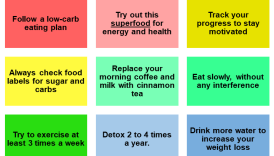The Roadmap to Sustainable Healthy Living

Defining Sustainable Healthy Living
Sustainable healthy living is all about making choices that benefit not only personal well-being but also the planet. It’s a lifestyle that integrates nutrition, physical activity, mental well-being, and eco-conscious decisions. For instance, someone who opts for a plant-based diet not only fuels their body with nutritious foods but also contributes to reducing greenhouse gas emissions.
- The Roadmap to Sustainable Healthy Living
- Defining Sustainable Healthy Living
- Importance of Adopting a Sustainable Lifestyle
- Nutrition for Sustainable Healthy Living
- Plant-Based Diet
- Impact of Food Choices on the Environment
- Physical Activity and Exercise
- Importance of Regular Exercise
- Sustainable Workout Practices
- Mental Health and Wellbeing
- Mindfulness and Stress Management
- Benefits of Connecting with Nature
- Sustainable Lifestyle Choices
- Eco-Friendly Products
- Waste Reduction and Recycling Initiatives
- Creating a Healthy Home Environment
- Indoor Air Quality
- Non-Toxic Cleaning Alternatives
- Building Sustainable Communities
- Community Gardens and Green Spaces
- Promoting Active Transportation Options
- Incorporating Mindful Consumption Habits
- Conscious Shopping Practices
- Ethical Fashion and Consumerism
- Embracing Alternative Health Practices
- Herbal Medicine and Traditional Healing
- Integrative Health Approaches
- Education and Advocacy for Sustainable Living
- Promoting Environmental Awareness
- Supporting Sustainable Policies and Practices
Importance of Adopting a Sustainable Lifestyle
Embracing a sustainable lifestyle is increasingly important for a variety of reasons:
- Health Benefits: Improved physical health and reduced risk of chronic diseases.
- Environmental Impact: Decreased carbon footprint and less waste generation.
- Community Wellbeing: Stronger, healthier communities through collective sustainable practices.
For example, when my neighbor joined a community garden project, not only did he enjoy fresh vegetables, but he also fostered a sense of community and connection with nature. Adopting such lifestyle choices allows individuals to live harmoniously with the environment while promoting personal health.
Nutrition for Sustainable Healthy Living
Plant-Based Diet
A plant-based diet is a cornerstone of sustainable healthy living. Focusing on whole foods such as fruits, vegetables, grains, nuts, and legumes not only nourishes the body but also supports environmental health. Personally, since switching to a more plant-focused diet, I’ve noticed increased energy levels and a better mood. It’s amazing how food choices can transform well-being! Here are a few benefits of adopting a plant-based diet:
- Enhanced Nutritional Intake: Rich in vitamins, minerals, and fibers.
- Lower Cholesterol Levels: Reducing the risk of heart disease.
- Variety of Flavors: Exploring new ingredients can be fun and adventurous.
Impact of Food Choices on the Environment
The choices we make about food have profound implications for the environment. For example, producing meat generally requires more resources, such as water and land, and generates higher emissions than plant-based foods. By choosing:
- Local Produce: Supports local farmers and reduces transportation emissions.
- Seasonal Eating: It minimizes environmental impact while ensuring freshness.
When I visit farmers’ markets and opt for seasonal, locally sourced foods, I feel more connected to my community and the earth. Each small choice contributes to a larger goal of sustainability, showing that our plates can play a crucial role in preserving the planet.
Physical Activity and Exercise
Importance of Regular Exercise
Regular exercise is a vital component of sustainable healthy living. It enhances physical fitness, boosts mental health, and increases longevity. Incorporating even small amounts of activity into daily routines can lead to significant improvements in overall well-being. Personally, I’ve found that my mood dramatically lifts after a brisk walk or a bit of dancing in my living room! Key benefits of regular exercise include:
- Improved Cardiovascular Health: Strengthens the heart and circulatory system.
- Enhanced Mental Clarity: Reduces anxiety and boosts cognitive function.
- Weight Management: Helps maintain a healthy weight through calorie balance.
Sustainable Workout Practices
When it comes to fitness, sustainability is just as important. Choosing eco-friendly workout practices not only benefits your health but also the planet. Here are some sustainable workout practices to consider:
- Outdoor Activities: Running, hiking, or cycling in nature helps appreciate the environment while staying fit.
- Community Classes: Joining local fitness groups reduces the carbon footprint associated with commuting to gyms.
- Eco-Friendly Gear: Opting for sustainable workout attire made from recycled or organic materials.
By making mindful choices in our exercise routines, we can foster a healthier lifestyle while contributing to the health of the planet!
Mental Health and Wellbeing
Mindfulness and Stress Management
Maintaining mental health is just as crucial as physical fitness in sustainable healthy living. Mindfulness and stress management techniques can dramatically enhance emotional well-being. I remember feeling overwhelmed with daily pressures until I discovered the calming practice of mindfulness meditation. Some effective mindfulness practices include:
- Deep Breathing: Simply focusing on your breath for a few minutes can reduce anxiety.
- Guided Imagery: Visualizing peaceful scenes can transport your mind to a calming space.
- Gratitude Journaling: Writing down things you are grateful for can shift your mindset towards positivity.
These practices help ground the mind, leading to a more balanced and peaceful life.
Benefits of Connecting with Nature
One of the most enriching ways to boost mental health is to connect with nature. Spending time outdoors can rejuvenate the spirit and enhance mood. Whether it’s a walk in the park or a weekend camping trip, nature has restorative powers. Benefits of spending time in nature include:
- Reduced Stress Levels: Natural settings lower cortisol levels, the hormone linked to stress.
- Improved Focus: Nature can enhance attention span and creativity.
- Enhanced Mood: Being in green spaces can promote feelings of happiness and contentment.
From my own experience, a simple stroll through a local botanical garden can do wonders for the soul, demonstrating how intertwining mental well-being with nature forms a vital aspect of sustainable living.
Sustainable Lifestyle Choices
Eco-Friendly Products
Making sustainable lifestyle choices often starts with the products we use daily. Opting for eco-friendly products not only reduces our environmental footprint but also promotes a healthier home and lifestyle. For example, I recently switched to biodegradable cleaning supplies, and not only do they work effectively, but I feel more confident knowing I’m being kind to the planet. Here are some eco-friendly product categories to consider:
- Natural Personal Care: Look for shampoos, soaps, and lotions that are free from harsh chemicals and packaged sustainably.
- Reusable Items: Invest in stainless steel water bottles, cloth bags, and food containers to minimize single-use plastics.
- Sustainable Home Goods: Choose furniture and decor made from sustainably sourced materials.
Waste Reduction and Recycling Initiatives
In addition to choosing eco-friendly products, engaging in waste reduction and recycling initiatives is crucial. It’s surprising how much waste we can minimize with a few simple changes. After I implemented a composting system at home, I noticed a significant decrease in my trash. Here are some effective strategies:
- Practice Composting: Convert organic waste into compost to enrich soil.
- Implement Recycling Programs: Familiarize yourself with your local recycling regulations to ensure proper disposal of materials.
- Reduce Single-Use Items: Strive to eliminate or reduce the use of disposable items in daily life.
By incorporating these practices, anyone can contribute to a more sustainable future, turning everyday choices into powerful acts of environmental stewardship.
Creating a Healthy Home Environment
Indoor Air Quality
A healthy home environment starts with good indoor air quality. Poor air quality can lead to various health issues, including allergies, respiratory problems, and fatigue. I vividly remember when I noticed a constant cough in my household; after some research, I discovered that improving our indoor air quality could make a substantial difference. Here are some tips to enhance indoor air quality:
- Ventilation: Regularly open windows to allow fresh air to circulate and remove stale air.
- Houseplants: Incorporate air-purifying plants like spider plants and snake plants to filter toxins naturally.
- Air Purifiers: Consider investing in an air purifier to reduce pollutants and allergens.
Non-Toxic Cleaning Alternatives
Alongside clean air, using non-toxic cleaning alternatives can further contribute to a healthier home. Many conventional cleaning products contain harmful chemicals that not only impact personal health but also indoor air quality. I shifted to DIY cleaning solutions and was amazed by how effective they could be! Here are some environmentally friendly cleaning alternatives:
- Vinegar and Water: A mixture of vinegar and water can effectively clean glass and surfaces.
- Baking Soda: Use baking soda as a gentle abrasive to scrub surfaces and neutralize odors.
- Essential Oils: Add a few drops of essential oils like tea tree or lavender to boost disinfectant properties.
Adopting these strategies ensures a home that promotes health and well-being, underscoring the connection between our living environment and sustainable choices.
Building Sustainable Communities
Community Gardens and Green Spaces
Building sustainable communities begins by nurturing community gardens and green spaces. These shared areas not only beautify neighborhoods but also empower residents to grow their own food, fostering connections with nature and each other. When I participated in my local community garden, I discovered a vibrant community where neighbors exchanged gardening tips and shared a bounty of homegrown produce. Here’s why community gardens matter:
- Food Security: They provide access to fresh, healthy food for local communities.
- Biodiversity: Enhancing local ecosystems by supporting a variety of plant and animal life.
- Social Ties: Strengthening relationships among residents through collaborative efforts.
Promoting Active Transportation Options
In addition to green spaces, encouraging active transportation options is essential for building sustainable communities. Walkable neighborhoods and bike-friendly paths not only improve public health but also reduce dependence on cars. Consider these strategies for promoting active transportation:
- Bike Lanes: Implement safe bike lanes to encourage cycling.
- Walking Trails: Develop pedestrian-friendly paths that connect neighborhoods to parks and commercial areas.
- Public Transport Access: Improve access to public transportation options to lessen the reliance on vehicles.
Through these initiatives, communities can foster a healthier, more sustainable lifestyle while enhancing social interaction and well-being. Creating green spaces and promoting active transport truly transforms the way we live and connect with our surroundings.
Incorporating Mindful Consumption Habits
Conscious Shopping Practices
Incorporating mindful consumption habits starts with conscious shopping practices. With so many options available, being intentional about purchases can greatly influence personal wellness and the environment. I used to buy impulsively, but now I approach shopping with a more thought-out strategy. Consider these conscious shopping tips:
- Make a List: Before heading out, create a list to avoid unwanted purchases.
- Research Brands: Look into companies that prioritize sustainability and ethical practices.
- Prioritize Quality Over Quantity: Invest in lasting items rather than cheap, disposable products.
Taking these steps can lead to a more sustainable lifestyle while reducing waste.
Ethical Fashion and Consumerism
Another critical component of mindful consumption is embracing ethical fashion. The fashion industry can be a significant contributor to environmental degradation, but making mindful choices can lead to a positive change. I found joy in thrifting and supporting local artisans, which not only helps the environment but also brings uniqueness to my wardrobe. Here are a few ethical fashion practices to consider:
- Support Sustainable Brands: Choose brands committed to eco-friendly practices and fair labor conditions.
- Shop Secondhand: Thrift stores and vintage fairs offer great finds with a lower environmental impact.
- Capsule Wardrobe: Create a capsule wardrobe with versatile pieces to minimize clutter and waste.
By practicing conscious shopping and supporting ethical fashion, individuals can significantly contribute to creating a more sustainable world—one purchase at a time.
Embracing Alternative Health Practices
Herbal Medicine and Traditional Healing
As we continue exploring sustainable living, embracing alternative health practices such as herbal medicine and traditional healing can have profound benefits. These practices offer natural remedies that harmonize well with both body and spirit. I’ve found great relief from seasonal allergies by using local herbal concoctions, connecting me to nature in a meaningful way. Consider these aspects of herbal medicine:
- Natural Remedies: Herbal teas and supplements can boost immunity and promote overall wellness.
- Cultural Insights: Many cultures possess rich traditions of healing using plants and natural resources, offering diverse approaches to health.
- Personal Connection: Creating herbal remedies enriches one’s knowledge about plants and their benefits.
Integrative Health Approaches
Transitioning to integrative health approaches combines multiple healing practices for a holistic view of wellness. This approach emphasizes the interplay between physical, mental, and emotional health. Personally, I’ve experienced the benefits of combining yoga, meditation, and nutrition counseling for a more comprehensive health journey. Here are some common integrative health practices:
- Mind-Body Techniques: Practices like yoga and tai chi improve physical fitness and mental clarity.
- Nutrition Therapy: Focusing on balanced diets tailored to individual needs promotes overall health.
- Collaborative Care: Engaging with various healthcare practitioners enables a broader perspective and treatment options.
By exploring herbal medicine and integrative health approaches, individuals can create a unique wellness journey that aligns with their values, enhancing both health and sustainability in their lives.
Education and Advocacy for Sustainable Living
Promoting Environmental Awareness
As the journey of sustainable living unfolds, education and advocacy play crucial roles in fostering environmental awareness. By sharing knowledge about the importance of sustainability, we inspire others to adopt eco-friendly practices. I remember attending a local workshop on composting, which not only educated me on reducing waste but also motivated my neighbors to join in! Here are some effective strategies to promote environmental awareness:
- Community Workshops: Organize events that focus on sustainable practices, like gardening, recycling, and energy conservation.
- Social Media Campaigns: Utilize social media to spread information and tips on sustainability to reach a larger audience.
- School Programs: Advocate for environmental education in schools to instill a sense of responsibility in younger generations.
Supporting Sustainable Policies and Practices
In addition to raising awareness, supporting sustainable policies and practices is essential. Engaging with local government initiatives can lead to meaningful change. I’ve actively participated in community meetings that discuss sustainable urban planning, allowing me to voice my concerns and suggestions. Consider these approaches to support sustainable policies:
- Advocacy Groups: Join or support organizations that focus on environmental issues and lobby for sustainable policies.
- Voting: Make informed voting choices by supporting candidates who prioritize environmental sustainability.
- Local Initiatives: Participate in community-led sustainability initiatives to foster a collective effort toward change.
By promoting environmental awareness and supporting sustainable policies, individuals can become catalysts for change, paving the way for a healthier planet and future generations to thrive.





